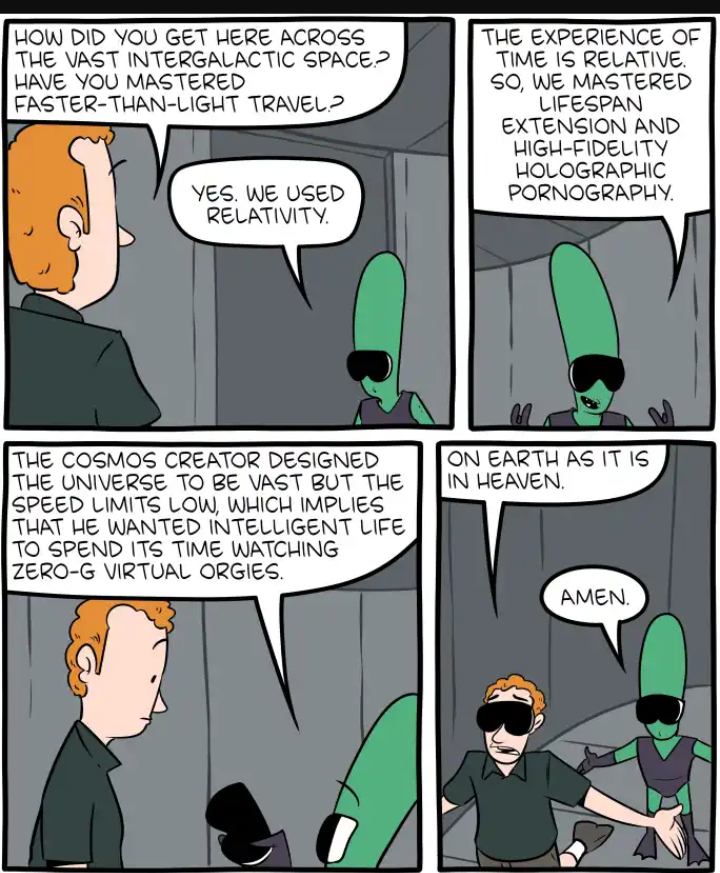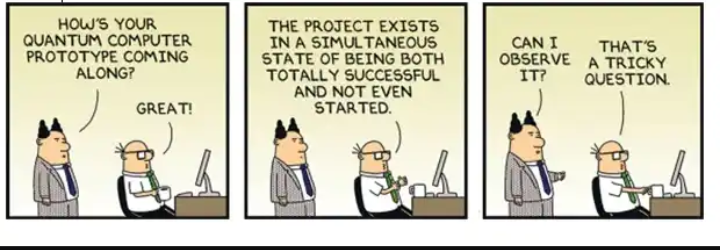Do Elementary Particles Actually Move Faster Than The Vacuum Speed Of Light ? - The Hidden Truth About Quantum Mechanics
In our previous article, we discussed some of the weird and counterintuitive quantum phenomena using simple scenarios for better clarification and understanding, these phenomena are only observable in the quantum world but to this day, it is not known why the quantum world behaves the way it behaves, most especially it's probabilistic nature. However, some scientists, including I have gone as far as trying to rewrite the foundations of the quantum mechanical laws/investigating why it (quantum world) is the way it is. To my surprise, the reason perhaps could be that elementary particles actually move faster than the vacuum speed of light but not in the way of violating Einstein's theory of special relativity which now has strong experimental footing.
Modern physics with respect to Einstein's theory of special relativity makes to know that massive objects cannot move at the vacuum speed of light and that in the classical world the maximum speed limit is also the vacuum speed of light - which brings about the constancy of the speed of light, in fact the theory of special relativity is a generalised theory of Newtonian Dynamics at all inertial reference frames(uniformly moving bodies) and the much more generalised theory being general relativity, which holds for non-inertial(accelerating) reference frames.
Well, if you observe closely, the theory (special relativity) specifically talks about "mass" and the "vacuum speed of light" being the maximum speed limit but we also know that elementary/subatomic particles also possesses another fundamental property called "charge". The charge just like mass, possesses a field around it (electric field) and if you observe the equations of the electric field and the Newton's gravitational field (since general relativity approximates to it at less massive scales), you would observe that they are kind of mimicking each other, charge looks like mass in another world but we call this world the electric world. Now, let's assume we had a particle with a charge but with no mass, the question then is, what is the speed range of this kind of particle in it's own world ?.
Tricky question right ?
Well, if you were like me and you took an educated guess, by saying that the speed range of this kind of particle, is that the minimum speed limit of this particle is the vacuum speed of light (instead of the vacuum speed of light being the maximum speed limit as in the case of the particle with only mass) and combining some other technical principles, then every of the quantum mechanical phenomena can be predicted. The core idea is that elementary/subatomic particles are moving with both the Newtonian speed (speed for only mass) and quantum speed (speed for only charge) at the same time but at different parallel worlds interconnected together, when we try to make sense of the quantum world with the principles of the Newtonian world, the weird quantum phenomena comes up.
Apart from my hypothesis, there are quantum mechanical phenomena that have been shown (both theoretically and experimentally) to suggest that faster than light principle might be at play in the quantum world and they are discussed below.
Superposition and Entanglement
When you move faster than the vacuum speed of light, weird things happens,
i. Casualty is broken - effect comes before the cause (which we all know is practically impossible in the classical world), you would have gotten to your destination before you started moving and it kind of leads to time traveling - you would be able to tell what happened in later time by communicating with the you that had already reached the destination before you started.
This kind of time traveling effect seems to have a role in the delayed choice experiment - an extension of the double slit experiment.
ii. You can be everywhere at the same time, in our previous example, you reached your destination before you started moving, this implies that you are both at your destination and at your starting point at the same time and from my hypothesis (discussed earlier) you can be at multiple places at the same time, depending on your Newtonian speed.
This leads to the so called "superposition of states", which also leads to "entanglement" as discussed in our previous article. As a matter of fact, experiment has shown that speeds necessary for entanglement/quantum non-local connection to take place are at least 10,000 times the speed of light.
Quantum tunneling
We discussed about this phenomenon in our previous article, a recent experiment has shown that quantum tunneling supports faster than light principle, that is when you take the ratio of the tunneling distance to the tunneling time, it yields speeds greater than the vacuum speed of light. For more informations see here.
There are other quantum phenomena that supports faster than light principle(s) which can be found in the references at the end of this article. However, some scientists including some of the early founders of quantum mechanics - Einstein and Schrodinger, refused to accept the faster than light explanation principle because they believe(d) it would violate Einstein's principles of special relativity. I on the other hand have shown in my research papers that faster than light principle can be incorporated into modern physics without violating the principles of special relativity - the mathematics can be constructed well.
For further reading
Faster-than-light, including quantum mechanical principles that supports it
For those interested in my research papers
Electromagnetism as the key to understanding the quantum world
Introduction to the basic principles of thermoelectricity and statistical electricity (edited)
Foundations of quantum mechanics revisited : mathematical reformalism
Thank you all once again for stopping by to read my jargons and also thank you @juecoree, @discovery-it and the @OCD team for your valuable supports.
Lastly, please don't forget to do the needful
Upvote
Comment
Reblog
If you enjoyed my jargons.





~2.jpeg)
I would disagree with your argument: "massive objects cannot move at the vacuum speed of light". I think that we can move any mass at the speed of light, but we need more energy to do so.
A lot in our equations and models mimics another. For example, the representation of our solar system seems to reflect the representation of the elementary particles in an atom. As you have mentioned, electric and gravitational field equations reflects same structure: Q = kq1q2/d^2 (Coulombs Law) while F = Gm1m2/d^2 (Newton's Universal gravitation), and it is not peculiar or coincidence. Both equations are looking at the force (electric and gravitational) between two bodies.
I would have it peg to zero. A particle of no mass but with charge seems to have no effect. If it still follows Newtonian mechanics, mass is a central point to quantify force and movement. If the particle has no mass, did the particle exist? It seems that the hypothetical particle exist without relevance. I might be wrong with this one since I am no expert on quantum mechanics.
I agree that in the future, there maybe a speed that is over the speed of light. The best candidate for moving beyond the speed of light is the elementary particles. Also, I do agree that there are peculiar things that would happen when we travel faster than light. Time travel can be achieved but it is time travel to the future and not back to the past. Or teleportation can be achieved. Quantum is a very tricky phenomenon and if we can understand it fully, we can see scientific and technological breakthrough.
This was an interesting read, @clinton19. !discovery 15
That's not my argument, it's the argument of special relativity. Also according to special relativity, giving massive objects more energy would only make them approach the vacuum speed of light, not make them move at the vacuum speed of light.
Oh, I thought that was your argument. Yeah, an infinite mass can't accelerate beyond the speed of light as per special relativity. !PIZZA
@clinton19! I sent you a slice of $PIZZA on behalf of @juecoree.
Learn more about $PIZZA Token at hive.pizza (1/10)
This post was shared and voted inside the discord by the curators team of discovery-it
Join our community! hive-193212
Discovery-it is also a Witness, vote for us here
Delegate to us for passive income. Check our 80% fee-back Program
Congratulations @clinton19! You have completed the following achievement on the Hive blockchain and have been rewarded with new badge(s) :
Your next target is to reach 3000 upvotes.
You can view your badges on your board and compare yourself to others in the Ranking
If you no longer want to receive notifications, reply to this comment with the word
STOPThanks for your contribution to the STEMsocial community. Feel free to join us on discord to get to know the rest of us!
Please consider supporting our funding proposal, approving our witness (@stem.witness) or delegating to the @stemsocial account (for some ROI).
Please consider using the STEMsocial app app and including @stemsocial as a beneficiary to get a stronger support.